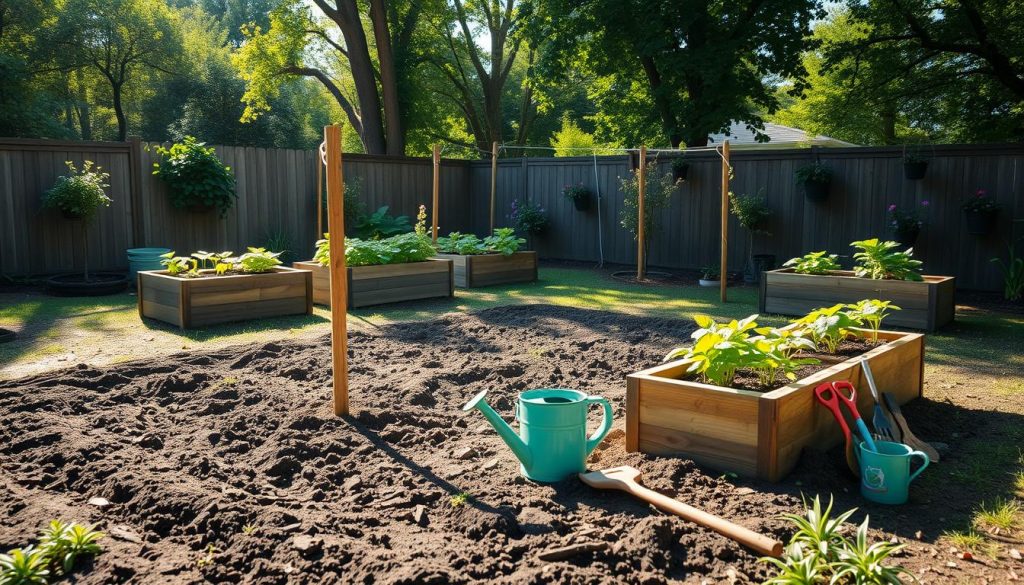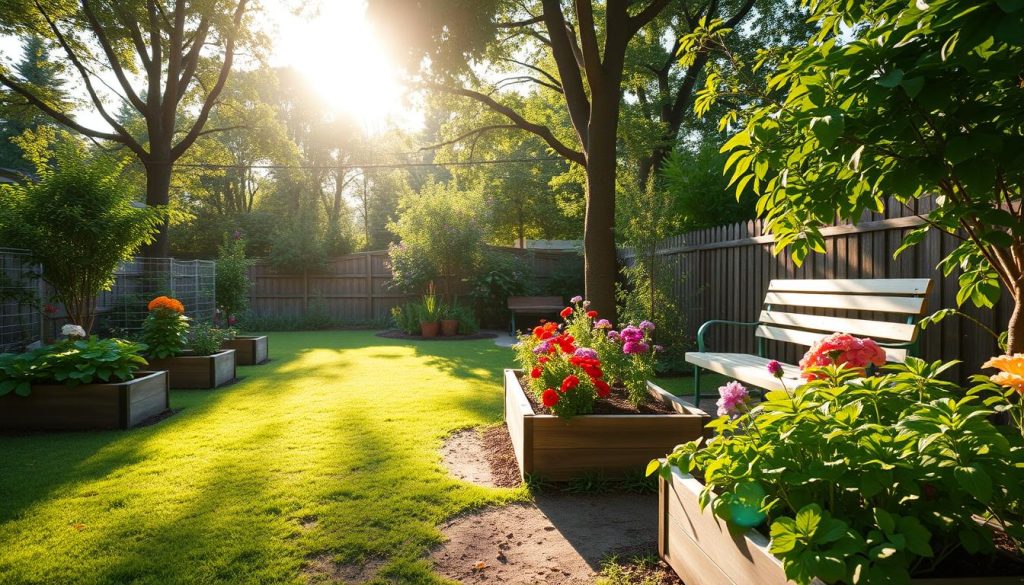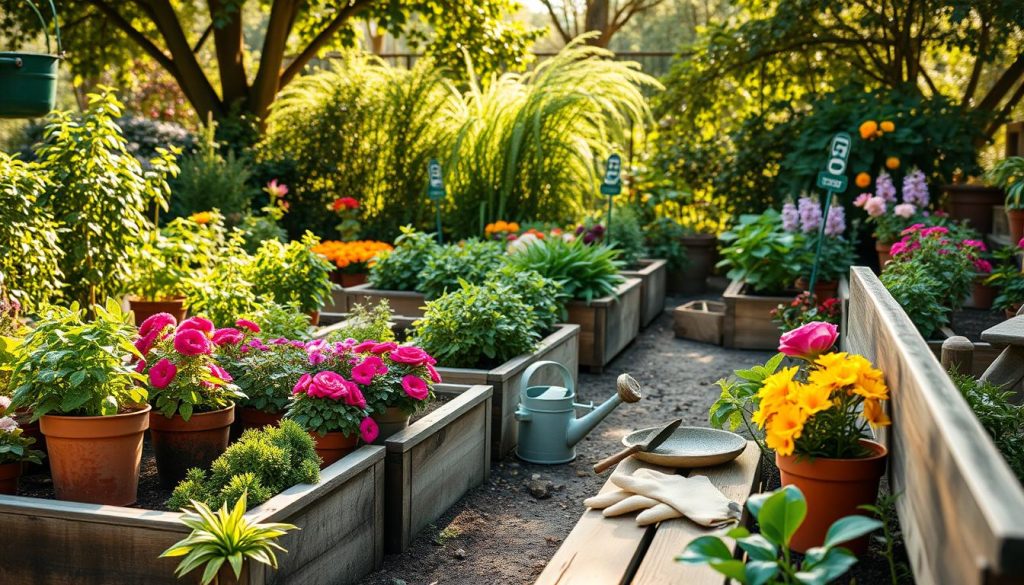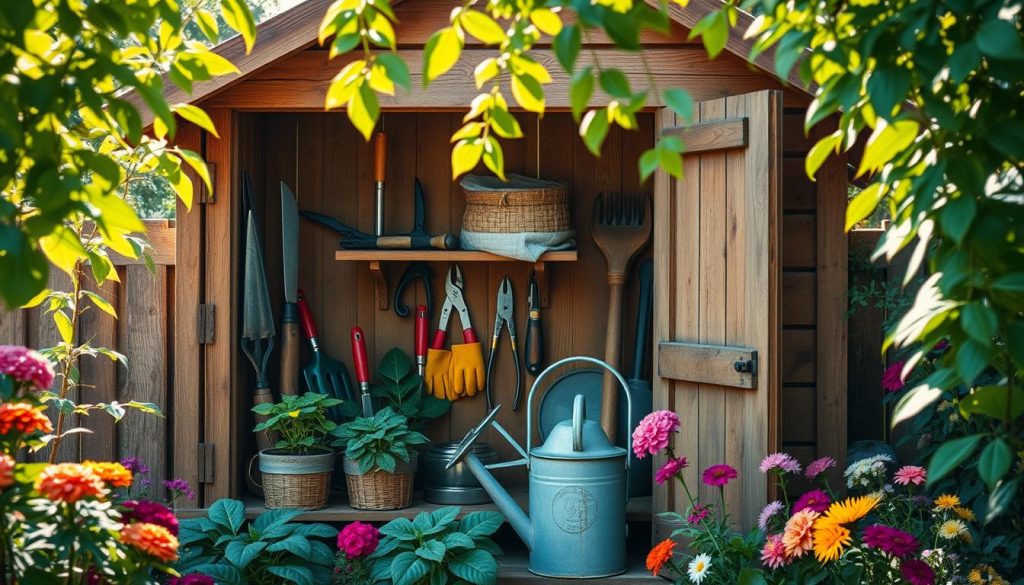Starting a garden can be both exciting and scary for beginners. But, with the right help, anyone can grow a beautiful garden. Beginner Gardening doesn’t have to be hard.
I’ll share easy steps to start gardening. We’ll cover the basics and offer tips for success. No matter the size of your space, I’ll help you create a garden that’s both enjoyable and productive.
Follow these simple methods, and you’ll soon become a skilled gardener. Gardening for beginners will become a fun and rewarding hobby.
Why I Started Gardening
I remember the moment I fell in love with gardening. It started with a simple wish to grow my own herbs and veggies. I began with a small garden on my balcony. Watching my plants grow, I found joy and many benefits.
Gardening offers physical and mental health perks. It also brings a sense of accomplishment. Sharing my harvest with loved ones made it even more special.
Exploring gardening, I learned about easy tips and starting from scratch. I found that anyone can grow a garden with the right tools and patience. Success in gardening comes from understanding the basics and being open to learning.

My First Gardening Experience
My first gardening journey was full of ups and downs. I made mistakes and faced challenges. But with each day, I grew more confident and passionate.
I started to enjoy the little things about gardening. Like the smell of fresh soil and the taste of a homegrown tomato.
What Gardening Means to Me
Gardening is more than a hobby to me; it’s a way of life. It connects me to nature and helps me relax. It’s a chance to create something beautiful and meaningful.
Whether starting a new garden or caring for my plants, I find joy. With the right tips and practice, I believe anyone can share my wonder and delight.
Choosing the Right Location for My Garden
When starting a garden, picking the right spot is key. I think about how much sunlight my garden will get. Most plants need at least six hours of direct sunlight a day. Herbs and flowers might need less.
To make sure my garden gets enough sunlight, I look at a few things:
- Orientation: The direction my garden faces matters. It affects how much sunlight it gets.
- Shading: Trees, buildings, or other things nearby can block sunlight, reducing it.
- Seasonal changes: Sunlight changes with the seasons. I need to plan for this.
It’s also important to pick a spot that’s easy to get to. I want to be able to water, care for, and pick my garden’s fruits and veggies easily. This makes gardening fun and rewarding.

By thinking about these points and picking the best spot, I can grow a garden that’s full of life and gives me fresh food all year. This makes my gardening journey a success with simple ideas.
| Plant Type | Sunlight Requirements |
|---|---|
| Vegetables | At least 6 hours of direct sunlight |
| Herbs | 4-6 hours of direct sunlight |
| Flowers | 4-6 hours of direct sunlight |
Selecting the Perfect Plants
Choosing the right plants for your garden can be tough for beginners. There are so many options, it’s key to pick what you like and what will grow well. Start with easy plants like tomatoes, cucumbers, and zucchini. Or go for colorful flowers like marigolds, sunflowers, and daisies.
When picking plants, use basic gardening tips. Check the labels for growing instructions. This helps you know where and how to care for them. Also, think about planting for each season to keep your garden lively all year.
Variety of Plants
- Vegetables: tomatoes, cucumbers, zucchini
- Flowers: marigolds, sunflowers, daisies

Seasonal Planting Ideas
Planting for each season keeps your garden interesting all year. Choose plants that do well in different times. This way, you’ll have a steady supply of fresh produce and flowers.
Essential Gardening Tools I Use
As a beginner gardener, the right tools are key to a successful garden. The right equipment ensures your plants get the care they need. For novice gardening advice, starting with essential tools is a smart move.
Begin with the basics for Beginner Gardening. Start with hand tools like a trowel, pruners, and a watering can. These tools help you plant, prune, and water your plants easily.
Hand Tools for Beginners
- Trowel: perfect for planting seeds and seedlings
- Pruners: great for trimming and pruning plants
- Watering can: ideal for watering plants without wasting water
Power Tools Worth Considering
As you get more gardening experience, power tools can be helpful. A lawn mower, trimmer, or cultivator can be great additions. They make bigger tasks easier.

Investing in these essential tools will help you create a beautiful garden. Always use power tools safely. Happy gardening!
Preparing Your Soil
Starting your gardening journey? Preparing your soil is key to a bountiful harvest. First, test your soil to know its pH level and nutrient content. This helps you see where your soil needs a boost, ensuring your plants get the best start.
For a lush garden, add compost or manure to your soil. It improves soil structure and fertility. This approach helps your plants grow strong and healthy, reducing the need for harmful chemicals.
Testing Soil Quality
Testing your soil is easy with a DIY kit or lab analysis. It reveals your soil’s pH, nutrient levels, and health. With this info, you can tailor your soil care to meet your plants’ needs.
Adding Nutrients and Compost
Boost your soil with nutrients and compost. You can make compost from kitchen scraps and leaves. It’s a green way to feed your plants and cut down on waste.
By following these tips, you’ll grow a garden full of life and flavor. Always test your soil and add nutrients and compost as needed. This will ensure your garden thrives.
| Soil Type | pH Level | Nutrient Content |
|---|---|---|
| Clay | 6.0-7.0 | High in nutrients, but poor drainage |
| Sandy | 7.0-8.0 | Low in nutrients, but good drainage |
| Loam | 6.0-7.0 | Balance of nutrients and drainage |
Starting Seeds Indoors
Starting a garden means giving plants a head start. Starting seeds indoors is a great way to do this. It lets you control the environment and help your seedlings grow well.
Choosing the Right Containers
Choosing the right containers is key for starting seeds indoors. Look for ones made for seed starting. They should be clean, sterile, and have good drainage. You can pick cell packs, seed trays, or small pots, depending on your seeds.
Light Requirements for Seedlings
Most seeds need 12-14 hours of light a day to grow. You can use grow lights or a sunny windowsill. Make sure the light isn’t too strong to avoid leggy or scorched seedlings. Start with low light and increase it as they grow.
Here are some tips for starting seeds indoors:
- Use a well-draining seed starting mix to prevent waterlogged soil.
- Keep the soil warm, around 70-80°F, to promote germination.
- Water the seedlings gently but thoroughly, making sure not to overwater.
By following these tips, you can give your garden a head start. Starting seeds indoors is a beginner-friendly way to enjoy a bountiful harvest. It’s a rewarding experience for anyone.
| Seed Type | Light Requirement | Temperature |
|---|---|---|
| Tomato | 12-14 hours | 70-80°F |
| Cucumber | 12-14 hours | 65-75°F |
| Herbs | 10-12 hours | 60-70°F |
Transplanting Seedlings
As I care for my seedlings, I’ve discovered that simple gardening tips can greatly help. Transplanting them into bigger containers or directly into the garden is a key step. It might seem daunting at first, but it’s easier than you think.
Before moving them, it’s important to harden off your seedlings. This means slowly getting them used to outdoor conditions. I transplant mine in the evening or on cloudy days to reduce stress.
When to Transplant
Timing is crucial for transplanting. I wait until my seedlings have 2-3 sets of leaves. This shows they’re ready for the next growth stage. This simple trick has led to healthier plants.
How to Transplant Successfully
To transplant successfully, I follow a few steps:
- Prepare the soil: I make sure the soil is well-draining and rich in nutrients to support my seedlings’ growth.
- Handle with care: I gently remove the seedlings from their containers, taking care not to damage their roots.
- Water thoroughly: I water my seedlings well after transplanting to help them settle into their new environment.
By following these simple tips, even beginner garden projects can flourish. Be patient and gentle when transplanting. Don’t be afraid to try new things to find what works best for you.
Caring for My Garden
As a novice gardener, I’ve learned that proper care is key for a thriving garden. By following basic gardening techniques, I’ve made a beautiful and productive outdoor space. Watering deeply but infrequently is crucial. It encourages deep root growth and prevents disease and pests.
Weeding and mulching are also vital. Regular weeding stops plants from competing for nutrients. Mulching around plants keeps moisture in and weeds out. These tips help keep my garden healthy and thriving. Here are some more tips:
- Water in the morning or early afternoon for better absorption.
- Use organic mulch to keep moisture in and weeds away.
- Remove weeds by hand or tool to stop seed spreading.
By following these tips, anyone can have a beautiful and productive garden. Always water deeply, weed regularly, and mulch around your plants. This will keep your garden thriving.
Organic Pest Control Methods
As a beginner gardener, it’s key to know about common pests and how to fight them organically. This is vital for a healthy garden. Gardening can be tough, but with the right methods, you can succeed and enjoy a great harvest.
Identifying Common Garden Pests
Some common pests are aphids, slugs, and snails. They can harm your plants a lot. So, spotting them early and acting fast is important. Here are some pests to watch for:
- Aphids: small, soft-bodied insects that feed on plant sap
- Slugs: slimy, nocturnal pests that feed on plant leaves and stems
- Snails: similar to slugs, but with a shell
Natural Remedies That Work
There are many natural ways to fight pests. These include:
- Neem oil: a natural insecticide that can be used to control aphids and other pests
- Garlic spray: a homemade spray made from garlic and water that can repel pests
- Diatomaceous earth: a natural substance that can be used to control slugs and snails
Harvesting Your Garden Bounty
Walking through my garden, I’m always excited to see the fruits of my labor. Harvesting is one of the most rewarding experiences for a gardener. It’s a great way to enjoy the easy gardening tips I’ve learned.
When starting a garden, knowing when to harvest is key. This ensures you get the best flavor and texture. Look for signs like color, texture, and size to know when to pick.
A ripe tomato will be red and slightly soft. A ripe cucumber will be dark green and firm. By following these tips, you’ll enjoy your harvest at its peak freshness.
Signs of Ripe Vegetables and Fruits
- Color: Check the color of your vegetables and fruits to see if they’ve reached their full ripeness.
- Texture: A ripe vegetable or fruit will be slightly soft to the touch, but still firm enough to hold its shape.
- Size: Check the size of your vegetables and fruits to see if they’ve reached their full growth potential.
Best Practices for Harvesting
When harvesting, use the right tools to avoid damaging your plants. Use scissors or a sharp knife to cut your vegetables and fruits. Handle them gently to avoid bruising.
By following these best practices, you’ll enjoy your harvest for weeks. You’ll be well on your way to starting a garden that will thrive for years.
Seasonal Gardening Tips
As a gardener, I’ve learned that each season has its own challenges and chances. To get the most from my garden, I’ve found ways to garden in winter and spring. With easy gardening tips, I can keep harvesting all year long.
Winter Gardening Strategies
To shield my plants from frost, I cover them with mulch or bring them inside. This keeps the soil warm and stops damage from cold. Other winter gardening tips include:
- Using cold frames or greenhouses to extend the growing season
- Planting winter-hardy crops like kale or spinach
- Using row covers to protect plants from wind and frost
Preparing for Spring
When the weather warms up, I start getting my garden ready for spring. I start seeds indoors, get the soil ready, and plan my garden’s layout. With simple gardening ideas, I create a stunning and fruitful garden for spring.
| Season | Gardening Tasks |
|---|---|
| Winter | Protect plants from frost, prune trees and shrubs |
| Spring | Start seeds indoors, prepare soil, plant spring crops |
Continuing My Gardening Journey
Reflecting on my gardening projects, I’m excited for what’s next. Joining local clubs and online groups has been a game-changer. They offer endless knowledge, support, and inspiration.
These groups have introduced me to fresh ideas in gardening. I’ve learned about sustainable practices and tips for solving gardening problems. Their help has been key to my growth.
Looking forward, I’m ready to try new things and share my love for gardening. The journey is just starting, but I’m confident. With the help of fellow gardeners, my garden will keep growing and improving.

